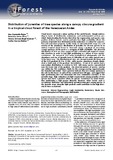Distribution of juveniles of tree species along a canopy closure gradientin a tropical cloud forest of the Venezuelan Andes
Fecha
2015-07-31Palabras Clave
Natural Regeneration, Light Availability, Understory, Shade Tolerance, Hemispherical Photography, Null ModelsMetadatos
Mostrar el registro completo del ítemResumen
Cloud forests represent a minor portion of the world forests, though outstanding in terms of biodiversity, endemisms, and environmental services provided. Understanding the factors that drive the regeneration and species composition of these forests, and in particular how light availability affects the patterns of juvenile tree distribution in the understory, is critical for conservation and restoration programs. In this study, we determined the range-size and overlap of the abundance distribution of juveniles for 20 tree species in an Andean tropical cloud forest in Venezuela along a gradient of percentage canopy openness (%CO) used as a surrogate of light availability. The observed distribution of %CO was then compared with a bounded null model of community structure in order to test light partitioning as a driver of tree species’ coexistence. We measured %CO using hemispherical photography and the abundance and size of juvenile trees in 280 plots of 1-m radius spread over a 32 ha forest area. The distribution of sites was skewed towards the lower end of the %CO gradient (0.5 to 12.8%), while species abundance sharply diminished at both ends of the gradient. Nevertheless, 15 out of 20 species had a non-random distribution in relation to %CO, with many species concentrated near the lower side of the gradient. The observed pattern of species’ overlap was within the 95% confidence limits for the average overlap expected under the bounded null model. These patterns indicate that low canopy openness is the rule in this forest, in spite of the scattered tree-fall gaps, and suggest that light partitioning does not determine the tree community structure at the juvenile stage. High redundancy in light requirements among juveniles of tree species may have a positive effect on species coexistence in cloud forests, thus maintaining a high species diversity. However, other factors such as recruitment limitation and differential growth/carbon-gain among species at the juvenile stage along the light gradient could contribute to the high diversity of these ecosystems.
Información Adicional
| Correo Electrónico | anaq@ula.ve teresas@ula.ve cgarcia@ula.ve |
| Editor | iForest |
| Citación | Quevedo Rojas, Ana; Jerez Rico, Mauricio; Schwarzkopf Kratzer, Teresa; García-Núñez, Carlos. Distribution of juveniles of tree species along a canopy closure gradientin a tropical cloud forest of the Venezuelan Andes. iForest 9: 363-369 2016 |
| Colación | e1 - e7 |
| Institución | Universidad de Los Andes |






